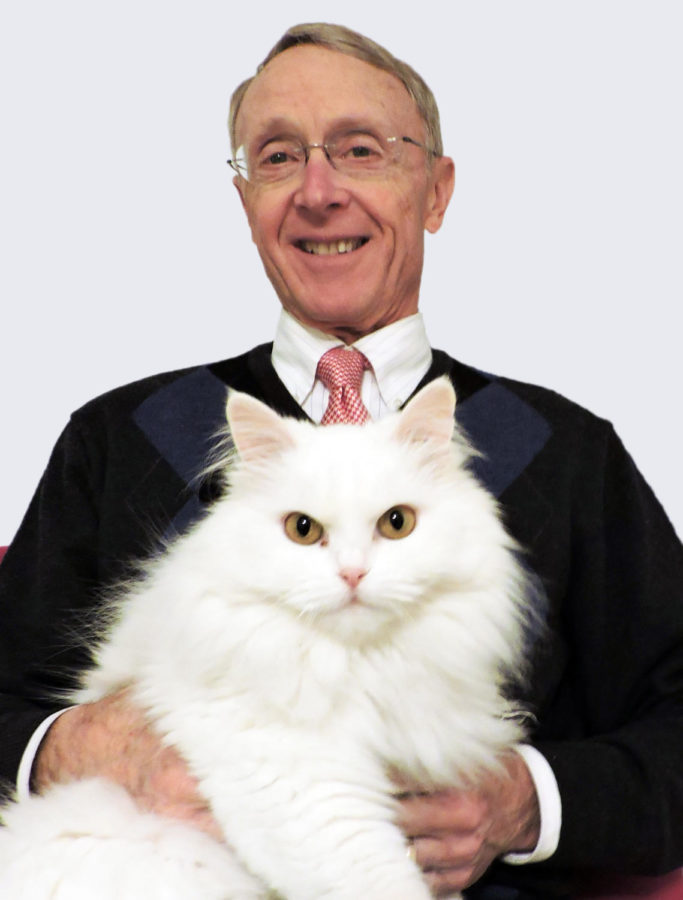Largest animal shelter in Iowa gets help from Iowa State employees
John McCarroll (2).jpg
January 20, 2018
A place where animals find sanctuary also serves as hands-on experience for Iowa State students and a way for Iowa State faculty and staff to give back.
The Animal Rescue League (ARL), founded in 1926, serves as Iowa’s largest non-profit animal shelter. Last year, ARL brought in 10,783 animals and facilitated the adoption of 6,940.
The main shelter is in Des Moines. Being just a 40 minute ride away, the shelter offers learning opportunities for Iowa State’s veterinary medicine students.
Some of Iowa State’s faculty and staff also spend time volunteering at ARL, even on holidays. John McCarroll, university relations director, and his wife spend Thanksgiving, Christmas, New Year’s Eve and more volunteering in order to give the staff some time off.
“I think I’m like a lot of our volunteers. We realize that the benefit is mutual. The benefit is as much to the human owner as it is to the animal,” McCarroll said. “The companionship, the friendship, emotional attachment has just as much benefit to us as it does to the cat or the dog or the horse or the bunny.”
McCarroll didn’t get involved with ARL until meeting his wife Mary McCarroll. Mary McCarroll has been involved since 1993 while her husband started getting involved around 2007.
John McCarroll said other Iowa State faculty help out at ARL including entomology professor Donald Lewis and his wife.
Mary McCarroll also volunteers by helping match people looking to adopt a cat with a new companion online.
“It’s like match.com for people except it’s for cats and I spend probably 20 to 25 hours a month doing that,” Mary McCarroll said. “It’s a neat process and that’s probably where I spend most of my time right now.”
The couple currently has five cats, all from the Animal Rescue League.
“All of them are senior kitties. We like to adopt older cats. They seem to have a harder time finding homes,” Mary McCarroll said. “I think it’s a hazard of being a volunteer. We’re out at the shelter a lot, so when we see a cat that we fall in love with it’s hard not to take them home.”
The McCarrolls also take part in the foster program where an animal temporarily stays with a family to give them the space to run around and explore which isn’t always accessible at a shelter. On top of their five cats, the couple typically fosters an additional cat.
Mary and John McCarroll both said at the end of their foster’s stay, it is always hard to let them go.
“We get attached to them. They fit right into our household,” Mary McCarroll said. “It’s hard, but we’ve been doing it for so many years, we know that they’re always going to go into a good home and many times we actually get to meet the potential adopters, so that really helps.”
Betsy Salmon is one of three foster coordinators at ARL. She said she also has the title of meow manager.
Salmon said depending on the time of year, ARL has greater need for certain types of foster families. In the spring, they need more people with neonatal or bottle baby experience, which are kittens under about four to five weeks of age.
In the summer, they need what she called “shelter cat get-a-way” foster homes. These are for cats that are ready for adoption and don’t need any special care, but will be more comfortable in a home with more space.
Once fall hits, ARL looks for cat behavior homes. These are for cats that come in more fearful or feral and may be tamed down in a foster home.
Salmon specializes in cats, but ARL’s foster programs extend to barn animals, dogs and smaller animals like rabbits. There are also programs for pet owners to ensure their pets will be taken care of in the event their pets outlive them.
Another program matches cats with offices looking for a workplace pet. More information on the foster program can be found at https://www.arl-iowa.org/get-involved/foster/.
In many cases, foster families become what ARL calls “foster failure.” This term sounds negative, but really means a foster family ended up adopting one of their foster animals.
“It happens a lot more often than folks really realize and it definitely happens more often to newer fosters than it does to experienced fosters,” Salmon said.
She estimated that about 75 percent of the time, newer fosters end up adopting.
Salmon also fosters on top of the five cats she owns. She said she has a room which gives half to the fosters and half to her cats.
She typically takes in bottle-baby kittens and said she will have about 75 to 100 of these kittens go through her home in a year, which are then sent out to other foster homes.
“[Fostering] can be rewarding for yourself and for the animal,” Salmon said. “So the animal is getting a break from being in a shelter environment and getting that one-on-one attention that it definitely deserves and it gets that enrichment. On top of that, having a pet around, especially a little adorable kitten, is super healthy.”







